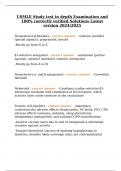USMLE Study test in depth Examination and
100% correctly verified Solutions Latest
version 2024/2025
Nonselective β-blockers - correct answer -Nadolol, pindolol
(partial agonist), propranolol, timolol
-Mostly go from N to Z
β1-selective antagonist - correct answer -acebutolol (partial
agonist), atenolol, betaxolol, esmolol, metoprolol
-Mostly go from A to M
Nonselective α- and β-antagonists - correct answer -Carvedilol,
labetalol
Nebevolol - correct answer -Combines cardiac-selective β1-
adrenergic blockade with stimulation of β3-receptors, which
activate nitric oxide synthase in the vasculature
Toxicity of β-blockers - correct answer -Impotence,
cardiovascular adverse effects (bradycardia, AV block, HF), CNS
adverse effects (seizures, sedation, sleep alterations),
dyslipidemia (metoprolol), and asthma/COPD exacerbations
-Avoid in cocaine users due to risk of unopposed α-adrenergic
receptor agonist activity
-Despite theoretical concern of masking hypoglycemia in
diabetics, benefits likely outweigh risks; not contraindicated
,Acetaminophen toxicity antidote - correct answer N-
acetylcysteine (replenishes glutathione)
AChE inhibitor/organophosphate toxicity antidote - correct
answer Atropine > pralidoxime
Amphetamines toxicity antidote - correct answer NH4Cl
(acidify urine)
Antimuscarinic, anticholinergic agents toxicity antidote - correct
answer Physostigmine salicylate, control hyperthermia
Benzodiasepines toxicity antidote - correct answer Flumazenil
β-blocker toxicity antidote - correct answer Glucagon
Carbon monoxide toxicity antidote - correct answer 100% O2,
hyperbaric O2 Penicillamine
Cyanide toxicity antidote - correct answer Nitrite +
thiosulfate, hydroxocobalamin
Digitalis toxicity antidote - correct answer Anti-dig Fab
fragments
Heparine toxicity antidote - correct answer Protamine sulfate
,Iron toxicity antidote - correct answer Deferoxamine,
deferasirox
Lead toxicity antidote - correct answer EDTA, dimercaprol,
succimer, penicillamine
Mercury, arsenic, gold toxicity antidote - correct answer
Dimercaprol (BAL), succimer
Copper, arsenic, gold toxicity antidote - correct answer
Penicillamine
Methanol, ethylene glycol (antifreeze) toxicity antidote - correct
answer Fomepizole > ethanol, dialysis
Methemoglobin toxicity antidote - correct answer Methylene
blue, vitamin C
Opioids toxicity antidote - correct answer Naloxone,
naltrexone
Salicylates toxicity antidote - correct answer NaHCO3
(alkalinize urine), dialysis
TCAs toxicity antidote - correct answer NaHCO3 (plasma
alkalinization)
, tPA, streptokinase, urokinase toxicity antidote - correct answer
Aminocaproic acid
Warfarin toxicity antidote - correct answer Vitamin K (delayed
effect), fresh frozen plasma (immediate)
Drugs that cause coronary vasospasm - correct answer
Cocaine, sumatriptan, ergot alkaloids
Drugs that cause cutaneous flushing - correct answer
Vancomycin, Adenosine, Niacin, Ca2+ channel blockers (VANC)
Drugs that cause dilated cardiomyopathy - correct answer
Anthracyclines (e.g., doxorubicin, daunorubicin); prevent with
dexrazoxane
Drugs that cause Torsades de pointes - correct answer Class
III (e.g., sotalol) and class IA (e.g., quinidine) antiarrhythmics,
macrolide antibiotics, antipsychotics, TCAs
Drugs that cause adrenocortical insufficiency - correct answer
HPA suppression 2° to glucocorticoid withdrawal
Drugs that cause hot flashes - correct answer Tamoxifen,
clomiphene
Drugs that cause hyperglycemia - correct answer Tacrolimus,
Protease inhibitors, Niacin, HCTZ,
Corticosteroids




